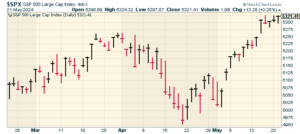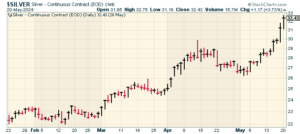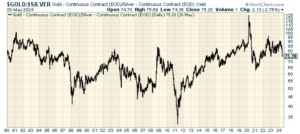CWS Market Review – May 21, 2024
(This is the free version of CWS Market Review. If you like what you see, then please sign up for the premium newsletter for $20 per month or $200 for the whole year. If you sign up today, you can see our two reports, “Your Handy Guide to Stock Orders” and “How Not to Get Screwed on Your Mortgage.”)
The S&P 500 has closed higher 11 times in the last 14 sessions. What’s interesting is how small those three drops have been.
The largest loss of the three came on May 16 when the index fell just 0.30%. By historical standards, that’s not much. The second-worst drop came on May 13 when the S&P 500 lost a tiny 0.02%, but that doesn’t compare with the absolutely miniscule loss from May 8.
On May 8, the S&P 500 closed lower by 0.03 points. In percentage terms, the S&P 500 lost 0.0006%. The drop from May 13 was 41 times that of the loss from May 8, and the loss from May 8 was tiny to begin with.
If the stock market were to suffer May 8’s loss every single trading day for 10 years, the combined loss would still be less than 1.5%.
The good news is that the S&P 500 closed at another all-time high today of 5,321.41. The index is now up 11.56% for the year. The S&P 500 hasn’t had a daily loss of more than 0.25% since May 1. The Wall Street adage to “sell in May and go away” isn’t holding up well this year.
The market has been helped in recent weeks by an earnings season that was better than expected. We nearly have all the numbers for Q1 and the S&P 500 posted Q1 earnings growth of 5.36%. One month ago, Wall Street had been expecting growth of just 0.38%. The market beat very low expectations.
There’s growing concern over exactly where the Federal Reserve stands. In fact, I think it’s possible we may see the Fed split into two camps in the coming months.
Earlier today, Fed Governor Christopher Waller gave a speech to the Peterson Institute for International Economics in Washington. This is noteworthy because Waller has gained a reputation as one of the most influential Fed members, perhaps second only to Jerome Powell. He’s also seen as one of the more hawkish members of the FOMC.
In his remarks, Waller noted that inflation is indeed slowing down and, for the time being, no more rate hikes are needed. However, Waller said that he wants to see more solid data before he’s convinced that the Fed should start cutting rates. This view could be gaining strength within the Fed. It seems to be a bit odd to call for rate cuts as the stock market is rallying and inflation is above the Fed’s own target.
Waller conceded that some recent economic reports have been weak, such as retail sales and manufacturing data. Higher rates take some time to work, but they’re clearly having an effect. Waller also said that there are signs that the labor market is loosening.
Specifically, Waller said, “in the absence of a significant weakening in the labor market, I need to see several more months of good inflation data before I would be comfortable supporting an easing in the stance of monetary policy.” That’s clearly different from what Powell has been saying.
Waller said that the recent inflation report was a pleasant surprise, but it wasn’t enough to alter his view. The next jobs report will be out on June 7. For now, Wall Street still sees the Fed cutting rates in September, but if Waller’s view gains strength, those rate cuts could be off the table.
Silver: The Poor Man’s Gold
Last month, William Herbert Hunt passed away at the age of 95. Forbes estimated his net worth at $5.3 billion.
I mention Mr. Hunt’s passing not only because he was a man of great wealth but also because he was involved in one of the most spectacular investment schemes in recent history. Forty-five years ago, Mr. Hunt and his brother, Nelson Bunker Hunt, tried to corner the world silver market.
The scheme failed and the Hunts lost billions. In two months, the Hunts’ silver position, including futures, fell from $7 billion to negative $1.7 billion, or as Nelson Bunker put it, “A billion dollars ain’t what it used to be.” Tell me about it. In 1990, Herbert Hunt filed for bankruptcy.
Silver, often called “the poor man’s gold,” has rallied impressively in recent weeks. It’s currently trading around $32 per ounce. That’s up from $22 per ounce less than three months ago. Buying silver is like buying gold but even more so. Silver is almost like a natural 2X or 3X gold ETF.
Yet even after this rally, silver is still going for well below its Hunt-induced peak from 45 years ago. At its height, silver breached $50 per ounce.
Gold now trades at 75 times silver. During the early part of Covid, the Gold/Silver ratio reached 125. The Gold/Silver ratio has been an important ratio through history. Way back in antiquity, Plato mentioned that the ratio was 12-to-1.
In 1792, the U.S. Congress, at the advice of Alexander Hamilton, passed the Coinage Act of 1792. This was the government’s first attempt at price-fixing (and it wasn’t the last). In other words, Hamilton pegged the Gold/Silver ratio at 15. He wasn’t quite right and in 1834, Congress had to bump it up to 16.
Here’s the Gold/Silver ratio since 1990:
When the Hunts launched their plan, silver was around $6 per ounce. By early 1980, it rose to $50 per ounce. Time Magazine estimated the Hunts made between $2 billion and $4 billion in just nine months. To pull this off, they had to borrow zillions of dollars. At one point, it was estimated that they held one-third of the world’s silver. Tiffany took out a full-page article to denounce them.
The Hunt brothers were the sons of the legendary oilman, Haroldson Lafayette “H.L” Hunt, Jr. Hunt the senior was one of those people who’s called eccentric, but if he’d had less money, he probably would have been called something else.
To give you an idea, H.L. Hunt wrote a novel outlining his ideas for a utopia called Alpaca. I recall one person calling it 1984, but Big Brother is the good guy. After he died, the Hunts learned that their father had two other families.
Another brother was Lamar Hunt who was one of the most influential people in the development of modern football. He helped start the AFL and owned the Kansas City Chiefs. He was the person who came up with the name “Super Bowl.” Each year, the winner of the AFC title game is awarded the Lamar Hunt trophy in his honor.
The Hunt brothers were convinced that the Establishment was out to crush them, and they were right. The exchange changed the margin requirement which forced the brothers to put up much more collateral. They soon faced a $100 million margin call.
On March 27, 1980, the bottom fell out of the silver market. This is now known as “Silver Thursday.” The Hunts had to put up more money, but they couldn’t reach their margin requirement. The government was worried that Wall Street banks were so much in debt to the Hunts that if the Hunts went under, so would the banks. A silver panic could start a banking panic. With a margin call, you either put up more money or sell. There is no third option. Eventually, a consortium of banks offered a $1 billion line of credit to keep the banking system going.
The Hunts were wiped out. The brothers eventually become the models for brothers Randolph and Mortimer Duke in the movie Trading Places.
Hunt’s son Bruce said of his father, “Yeah, we took some hits. But his whole deal was: That’s the past. Let’s look forward. Let’s go back to what we do.”
That’s all for now. I’ll have more for you in the next issue of CWS Market Review.
– Eddy
Posted by Eddy Elfenbein on May 21st, 2024 at 6:34 pm
The information in this blog post represents my own opinions and does not contain a recommendation for any particular security or investment. I or my affiliates may hold positions or other interests in securities mentioned in the Blog, please see my Disclaimer page for my full disclaimer.
-
-
Archives
- June 2025
- May 2025
- April 2025
- March 2025
- February 2025
- January 2025
- December 2024
- November 2024
- October 2024
- September 2024
- August 2024
- July 2024
- June 2024
- May 2024
- April 2024
- March 2024
- February 2024
- January 2024
- December 2023
- November 2023
- October 2023
- September 2023
- August 2023
- July 2023
- June 2023
- May 2023
- April 2023
- March 2023
- February 2023
- January 2023
- December 2022
- November 2022
- October 2022
- September 2022
- August 2022
- July 2022
- June 2022
- May 2022
- April 2022
- March 2022
- February 2022
- January 2022
- December 2021
- November 2021
- October 2021
- September 2021
- August 2021
- July 2021
- June 2021
- May 2021
- April 2021
- March 2021
- February 2021
- January 2021
- December 2020
- November 2020
- October 2020
- September 2020
- August 2020
- July 2020
- June 2020
- May 2020
- April 2020
- March 2020
- February 2020
- January 2020
- December 2019
- November 2019
- October 2019
- September 2019
- August 2019
- July 2019
- June 2019
- May 2019
- April 2019
- March 2019
- February 2019
- January 2019
- December 2018
- November 2018
- October 2018
- September 2018
- August 2018
- July 2018
- June 2018
- May 2018
- April 2018
- March 2018
- February 2018
- January 2018
- December 2017
- November 2017
- October 2017
- September 2017
- August 2017
- July 2017
- June 2017
- May 2017
- April 2017
- March 2017
- February 2017
- January 2017
- December 2016
- November 2016
- October 2016
- September 2016
- August 2016
- July 2016
- June 2016
- May 2016
- April 2016
- March 2016
- February 2016
- January 2016
- December 2015
- November 2015
- October 2015
- September 2015
- August 2015
- July 2015
- June 2015
- May 2015
- April 2015
- March 2015
- February 2015
- January 2015
- December 2014
- November 2014
- October 2014
- September 2014
- August 2014
- July 2014
- June 2014
- May 2014
- April 2014
- March 2014
- February 2014
- January 2014
- December 2013
- November 2013
- October 2013
- September 2013
- August 2013
- July 2013
- June 2013
- May 2013
- April 2013
- March 2013
- February 2013
- January 2013
- December 2012
- November 2012
- October 2012
- September 2012
- August 2012
- July 2012
- June 2012
- May 2012
- April 2012
- March 2012
- February 2012
- January 2012
- December 2011
- November 2011
- October 2011
- September 2011
- August 2011
- July 2011
- June 2011
- May 2011
- April 2011
- March 2011
- February 2011
- January 2011
- December 2010
- November 2010
- October 2010
- September 2010
- August 2010
- July 2010
- June 2010
- May 2010
- April 2010
- March 2010
- February 2010
- January 2010
- December 2009
- November 2009
- October 2009
- September 2009
- August 2009
- July 2009
- June 2009
- May 2009
- April 2009
- March 2009
- February 2009
- January 2009
- December 2008
- November 2008
- October 2008
- September 2008
- August 2008
- July 2008
- June 2008
- May 2008
- April 2008
- March 2008
- February 2008
- January 2008
- December 2007
- November 2007
- October 2007
- September 2007
- August 2007
- July 2007
- June 2007
- May 2007
- April 2007
- March 2007
- February 2007
- January 2007
- December 2006
- November 2006
- October 2006
- September 2006
- August 2006
- July 2006
- June 2006
- May 2006
- April 2006
- March 2006
- February 2006
- January 2006
- December 2005
- November 2005
- October 2005
- September 2005
- August 2005
- July 2005



 Eddy Elfenbein is a Washington, DC-based speaker, portfolio manager and editor of the blog Crossing Wall Street. His
Eddy Elfenbein is a Washington, DC-based speaker, portfolio manager and editor of the blog Crossing Wall Street. His